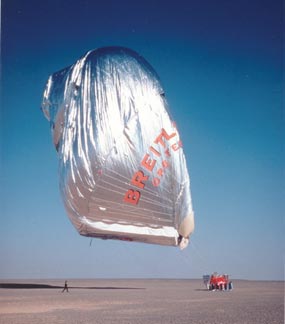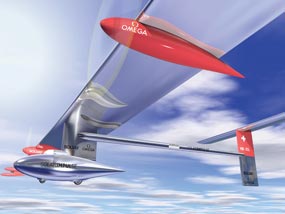
|
 |

Exploring New Horizons
Following on from his successful mission to become the first person to circumnavigate the globe in a balloon, Bertrand Piccard has now set his sights on developing a solarpowered plane. He tells Richard Middleton why he needs to push himself to the limit.
On a scorching day in March 1999, as the Egyptian desert baked under 40ºC heat, the Breitling Orbiter 3 balloon descended back to Earth, completing an epic flight in aviation history. That moment marked the culmination of one man’s vision and the six years he had devoted to completing the flight. Bertrand Piccard was born in 1958 in Lausanne, Switzerland, into a family of explorers, scientists and adventurers. His father, Jacques Piccard, was the first person to dive to the deepest oceanic trench, while his grandfather, Auguste, was the first to explore the stratosphere. Talking to Piccard, it is clear that his family’s adventurous background has shaped his life, and he seems a man very much at ease with himself and his achievements. ‘My father worked for NASA for a time, so as a child I was able to meet most of the Apollo crews,’ he says. ‘That’s when I decided I wanted a life like that, of exploration and adventure.’ Piccard studied psychiatry to doctorate level, after which he worked in a Swiss hospital. Talking to him, it is clear that this interest has never left him, and his calm, measured but ambitious attitude towards life comes from his adventurous family and his fascination with what makes humans behave the way they do, especially in extreme situations. Taking flight ‘I loved hang-gliding, but when I came to ballooning it changed the way I looked at the world. When you float in a balloon, you have to deal with the unknown. You fly with the wind; you allow it to carry you along its path and you have to deal with the challenges it lays before you. I love that part of the sport.’
Piccard quickly gained his Balloon Pilot licence before entering and winning the Chrysler Challenge in 1992 with the first transatlantic balloon flight. He then set his sights on becoming the first person to circumnavigate the globe in a hot air balloon. ‘It is the same as the mountaineer who wants to climb Everest or the astronaut who dreams about going to the moon,’ says Piccard. ‘I dreamed about flying non-stop around the world. It was the last holy grail of aeronautics, the last great adventure of the century.’ A long journey It was around this time, in the mid-1990s, that the dream of becoming the first person to fly non-stop around the world in a balloon came to the attention of the media, most notably with the high-profile attempts of Richard Branson and Steve Fosset.
|
Ballooning is not cheap. It costs around £3,500 to fill a sport balloon with sufficient helium, coupled with at least £150,000 to purchase the balloon itself. Piccard managed to get sponsorship from Swiss watch manufacturer Breitling, which was eager to associate itself with such an iconic record attempt. He then visited the renowned balloon firm Cameron’s of Bristol, which had built the balloon he used for his Atlantic triumph in 1992. He then formed his team, which included 50 people directly involved on the first flight attempt, from engineers and control centre staff to weathermen and physicists. ‘I was really positive before the first attempt,’ explains Piccard. ‘We had a team with synergy, a mixture of experts all working towards one goal. But we also had people who thought outside of the box, and that was really important.’ However, after four years of meticulous preparation and planning, the attempt was a failure: ‘We took off from Switzerland. After a few hours we had major technical problems and were forced to ditch into the Mediterranean. That was just a horrible, horrible feeling. But I remember thinking to myself that if it was easy, someone else would have done it.’ Piccard made a second attempt in 1998. The team made steady progress until Chinese airspace loomed. Unable to gain permission from the authorities, Piccard was again forced to ditch, this time in Burma. Undeterred, Piccard regrouped his team and lobbied the Chinese authorities, eventually gaining permission to pass over a narrow corridor of Chinese airspace. Meanwhile, his team developed a new course that would drag the balloon towards North Africa, before catching jet streams to carry it around the globe.
The winning trip Climbing to heights of 12,000m, the balloon made use of jet streams to travel at up to 180kph, making steady progress through the skies of Africa, then across the vast expanses of India, southern Asia and the Atlantic Ocean. Living in the sky was not easy. Apart from fresh vegetables during the first week, they were limited to re-hydrated foods for the rest of the voyage. Conditions were cramped as the duo took turns to man the balloon 24 hours a day, and several excursions outside the cabin were required to deal with technical problems. However, it was the fear of failure that frightened Piccard more than any skywalks at 10,000m. The longer they remained airborne and the closer Piccard came to completing his goal, the tenser he grew. It was 19 days and 21 hours after the voyage had begun that the balloon was finally allowed to start descending. Landing on an Egyptian desert plateau, 300 miles from Cairo, Piccard and Jones were left to reflect on their achievement in a strange solitude: ‘We’d lived in the sky for 20 days. We just sat there with relief that after six years of trying, hoping and praying, we had succeeded. I remember looking to the sky and saying thank you.’ Pushing the boundaries
‘The plane, Solar Pulse, will have a huge 250ft-wingspan and use solar power to charge batteries,’ he explains. ‘These will power the plane through the night, then recharge come daybreak.’ Coming from a family steeped in exploration and adventure, pushing the boundaries is part of Piccard’s heritage. And with his dreams of perpetual flight, he clearly has every intention of making it part of his future. |
|||








